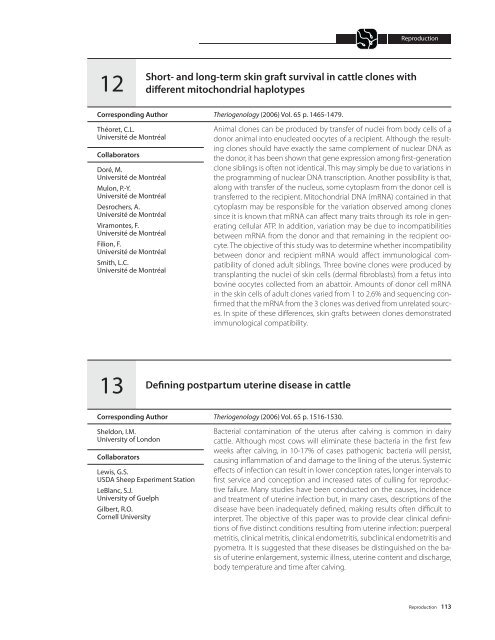A52-75-2007E.pdf - AgroMedia International Inc
A52-75-2007E.pdf - AgroMedia International Inc
A52-75-2007E.pdf - AgroMedia International Inc
Create successful ePaper yourself
Turn your PDF publications into a flip-book with our unique Google optimized e-Paper software.
Reproduction12Short- and long-term skin graft survival in cattle clones withdifferent mitochondrial haplotypesCorresponding AuthorThéoret, C.L.Université de MontréalCollaboratorsDoré, M.Université de MontréalMulon, P.-Y.Université de MontréalDesrochers, A.Université de MontréalViramontes, F.Université de MontréalFilion, F.Université de MontréalSmith, L.C.Université de MontréalTheriogenology (2006) Vol. 65 p. 1465-1479.Animal clones can be produced by transfer of nuclei from body cells of adonor animal into enucleated oocytes of a recipient. Although the resultingclones should have exactly the same complement of nuclear DNA asthe donor, it has been shown that gene expression among first-generationclone siblings is often not identical. This may simply be due to variations inthe programming of nuclear DNA transcription. Another possibility is that,along with transfer of the nucleus, some cytoplasm from the donor cell istransferred to the recipient. Mitochondrial DNA (mRNA) contained in thatcytoplasm may be responsible for the variation observed among clonessince it is known that mRNA can affect many traits through its role in generatingcellular ATP. In addition, variation may be due to incompatibilitiesbetween mRNA from the donor and that remaining in the recipient oocyte.The objective of this study was to determine whether incompatibilitybetween donor and recipient mRNA would affect immunological compatibilityof cloned adult siblings. Three bovine clones were produced bytransplanting the nuclei of skin cells (dermal fibroblasts) from a fetus intobovine oocytes collected from an abattoir. Amounts of donor cell mRNAin the skin cells of adult clones varied from 1 to 2.6% and sequencing confirmedthat the mRNA from the 3 clones was derived from unrelated sources.In spite of these differences, skin grafts between clones demonstratedimmunological compatibility.13Defining postpartum uterine disease in cattleCorresponding AuthorSheldon, I.M.University of LondonCollaboratorsLewis, G.S.USDA Sheep Experiment StationLeBlanc, S.J.University of GuelphGilbert, R.O.Cornell UniversityTheriogenology (2006) Vol. 65 p. 1516-1530.Bacterial contamination of the uterus after calving is common in dairycattle. Although most cows will eliminate these bacteria in the first fewweeks after calving, in 10-17% of cases pathogenic bacteria will persist,causing inflammation of and damage to the lining of the uterus. Systemiceffects of infection can result in lower conception rates, longer intervals tofirst service and conception and increased rates of culling for reproductivefailure. Many studies have been conducted on the causes, incidenceand treatment of uterine infection but, in many cases, descriptions of thedisease have been inadequately defined, making results often difficult tointerpret. The objective of this paper was to provide clear clinical definitionsof five distinct conditions resulting from uterine infection: puerperalmetritis, clinical metritis, clinical endometritis, subclinical endometritis andpyometra. It is suggested that these diseases be distinguished on the basisof uterine enlargement, systemic illness, uterine content and discharge,body temperature and time after calving.Reproduction 113





